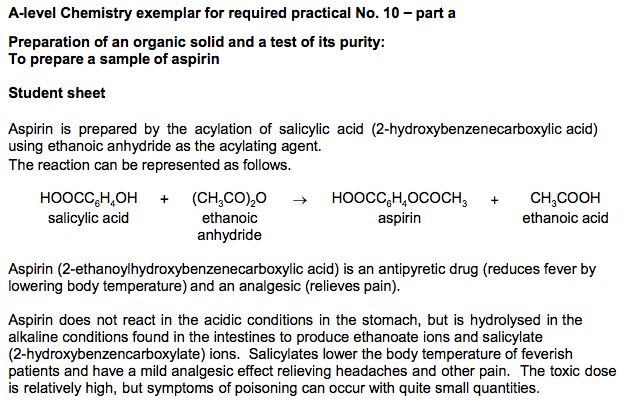
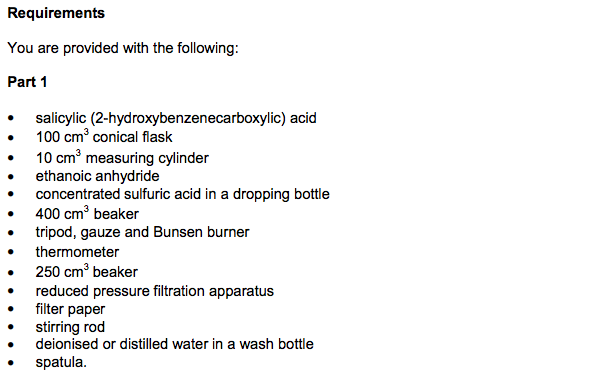
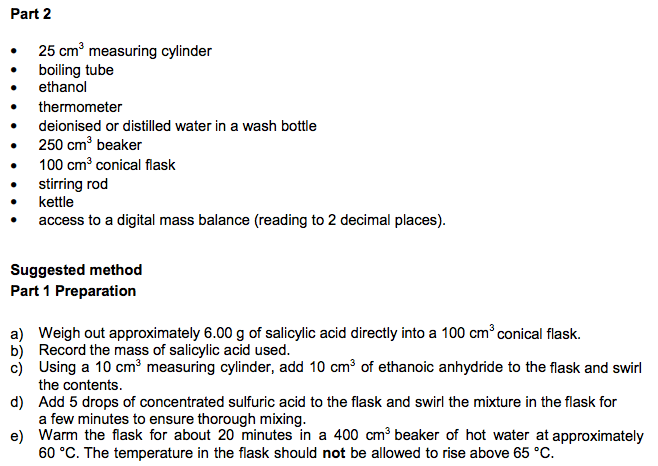
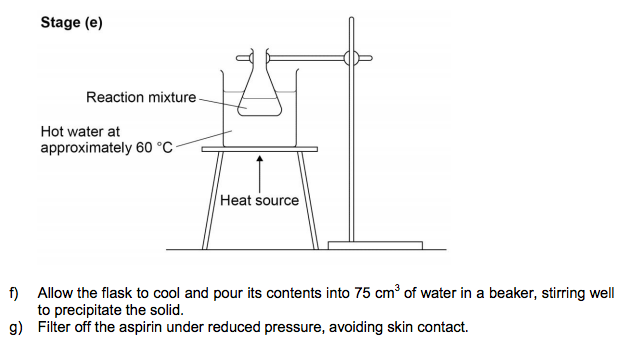
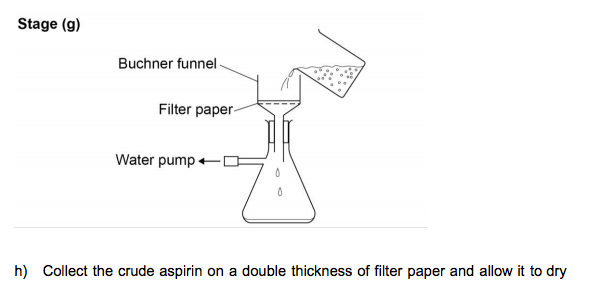
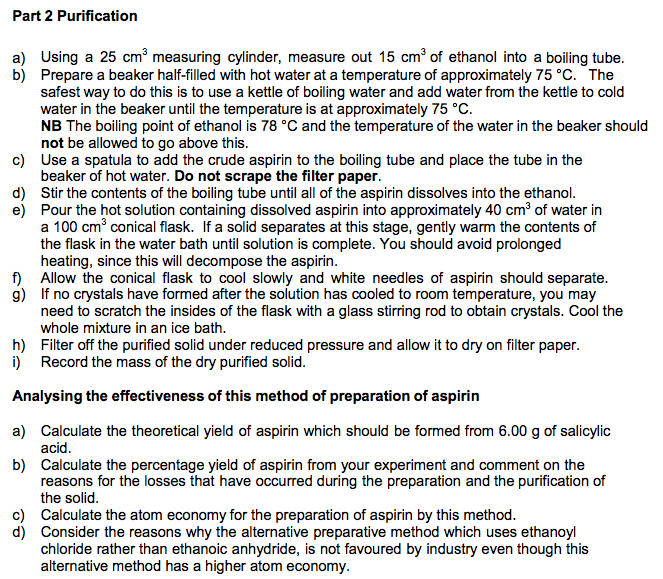



A-level Chemistry exemplar for required practical No. 10 – part a Preparation of an organic solid and a test of its purity: To prepare a sample of aspirin Student sheet Aspirin is prepared by the acylation of salicylic acid (2-hydroxybenzenecarboxylic acid) using ethanoic anhydride as the acylating agent. The reaction can be represented as follows. HOOCC6H4OH + (CH3CO)2O HOOCC6H4OCOCH3 + CH3COOH salicylic acid ethanoic anhydride aspirin ethanoic acid Aspirin (2-ethanoylhydroxybenzenecarboxylic acid) is an antipyretic drug (reduces fever by lowering body temperature) and an analgesic (relieves pain). Aspirin does not react in the acidic conditions in the stomach, but is hydrolysed in the alkaline conditions found in the intestines to produce ethanoate ions and salicylate (2-hydroxybenzencarboxylate) ions. Salicylates lower the body temperature of feverish patients and have a mild analgesic effect relieving headaches and other pain. The toxic dose is relatively high, but symptoms of poisoning can occur with quite small quantities. Requirements You are provided with the following: Part 1 salicylic (2-hydroxybenzenecarboxylic) acid 100 cm3 conical flask 10 cm3 measuring cylinder ethanoic anhydride concentrated sulfuric acid in a dropping bottle 400 cm3 beaker tripod, gauze and Bunsen burner thermometer 250 cm3 beaker reduced pressure filtration apparatus filter paper stirring rod deionised or distilled water in a wash bottle spatula. Part 2 25 cm3 measuring cylinder boiling tube ethanol thermometer deionised or distilled water in a wash bottle 250 cm3 beaker 100 cm3 conical flask stirring rod kettle access to a digital mass balance (reading to 2 decimal places). Suggested method Part 1 Preparation a) Weigh out approximately 6.00 g of salicylic acid directly into a 100 cm 3 conical flask. b) Record the mass of salicylic acid used. c) Using a 10 cm 3 measuring cylinder, add 10 cm 3 of ethanoic anhydride to the flask and swirl the contents. d) Add 5 drops of concentrated sulfuric acid to the flask and swirl the mixture in the flask for a few minutes to ensure thorough mixing. e) Warm the flask for about 20 minutes in a 400 cm 3 beaker of hot water at approximately 60 °C. The temperature in the flask should not be allowed to rise above 65 °C. f) Allow the flask to cool and pour its contents into 75 cm 3 of water in a beaker, stirring well to precipitate the solid. g) Filter off the aspirin under reduced pressure, avoiding skin contact.h) Collect the crude aspirin on a double thickness of filter paper and allow it to dry Part 2 Purification a) Using a 25 cm3 measuring cylinder, measure out 15 cm3 of ethanol into a boiling tube. b) Prepare a beaker half-filled with hot water at a temperature of approximately 75 °C. The safest way to do this is to use a kettle of boiling water and add water from the kettle to cold water in the beaker until the temperature is at approximately 75 °C. NB The boiling point of ethanol is 78 °C and the temperature of the water in the beaker should not be allowed to go above this. c) Use a spatula to add the crude aspirin to the boiling tube and place the tube in the beaker of hot water. Do not scrape the filter paper. d) Stir the contents of the boiling tube until all of the aspirin dissolves into the ethanol. e) Pour the hot solution containing dissolved aspirin into approximately 40 cm 3 of water in a 100 cm3 conical flask. If a solid separates at this stage, gently warm the contents of the flask in the water bath until solution is complete. You should avoid prolonged heating, since this will decompose the aspirin. f) Allow the conical flask to cool slowly and white needles of aspirin should separate. g) If no crystals have formed after the solution has cooled to room temperature, you may need to scratch the insides of the flask with a glass stirring rod to obtain crystals. Cool the whole mixture in an ice bath. h) Filter off the purified solid under reduced pressure and allow it to dry on filter paper. i) Record the mass of the dry purified solid. Analysing the effectiveness of this method of preparation of aspirin a) Calculate the theoretical yield of aspirin which should be formed from 6.00 g of salicylic acid. b) Calculate the percentage yield of aspirin from your experiment and comment on the reasons for the losses that have occurred during the preparation and the purification of the solid. c) Calculate the atom economy for the preparation of aspirin by this method. d) Consider the reasons why the alternative preparative method which uses ethanoyl chloride rather than ethanoic anhydride, is not favoured by industry even though this alternative method has a higher atom economy. To test the purity of an organic solid by measuring its melting point The purity of an organic solid can be determined in part by measuring its melting point and comparing the value with the known Data Book value of the melting point for that compound. A pure dry solid will melt at a precise temperature whereas an impure solid will melt over a range of temperatures which are lower than the melting point of the pure solid. Melting point apparatus varies in type from the most simple using an oil bath to the more sophisticated electrothermal devices. In every case, the same general principle applies that the heating of a small quantity of the solid in a thin-walled melting point tube should be undertaken slowly and with care. When melting occurs, the solid should collapse into a liquid without any change in temperature and the way in which this occurs can give a clue to the purity of the solid. Repeat measurements should be taken with further samples of the organic solid to verify the reliability of the value obtained. The method will not work if the solid decomposes on heating. Requirements You are provided with the following: pure benzenecarboxylic acid other pure organic solids as desired by the centre thermometer (0 °C to 250 °C range) melting point apparatus to include either: an electrothermal melting point apparatus or oil bath (Thiele tube or small beaker halffilled with mineral oil) tripod, gauze and Bunsen burner rubber ring to attach melting point tube to thermometer (if needed) melting point tubes watch glass spatula.Suggested method a) Powder a sample of the organic solid by crushing it gently with a spatula onto the surface of a filter paper. b) Fill three melting point tubes with the organic solid to a depth of approximately 0.5 cm. c) Set up the melting point apparatus provided and mount one of the melting point tubes ready for taking a measurement. d) Heat the apparatus gently and observe the temperature at which the solid collapses into a liquid. The melting point will be in the range 100 °C to 200 °C. e) Allow the melting point apparatus to cool and repeat the measurement of the melting point of the solid with the other two samples. If the first reading is taken as an approximate value, then the subsequent heating of the other two samples can be done much more slowly as this approximate value is approached. f) On the basis of the three measurements that you have taken, record the melting point of the organic solid. g) Ask your teacher for the Data Book value of the melting point for the solid that you have tested and compare this value with your own.
/
~
~
~
/
3.3.9.2 Acylation (A-level only)
Required practical 10
Preparation of:
• a pure organic solid and test of its purity


 3.9 Carboxylic Acids And Derivatives Page 6 - 7
3.9 Carboxylic Acids And Derivatives Page 6 - 7 Practical Guide Page : 153 - 157
Practical Guide Page : 153 - 157 Oxford Textbook Pages : 519 - 520
Oxford Textbook Pages : 519 - 520 CGP Revision Guide Pages : 171
CGP Revision Guide Pages : 171